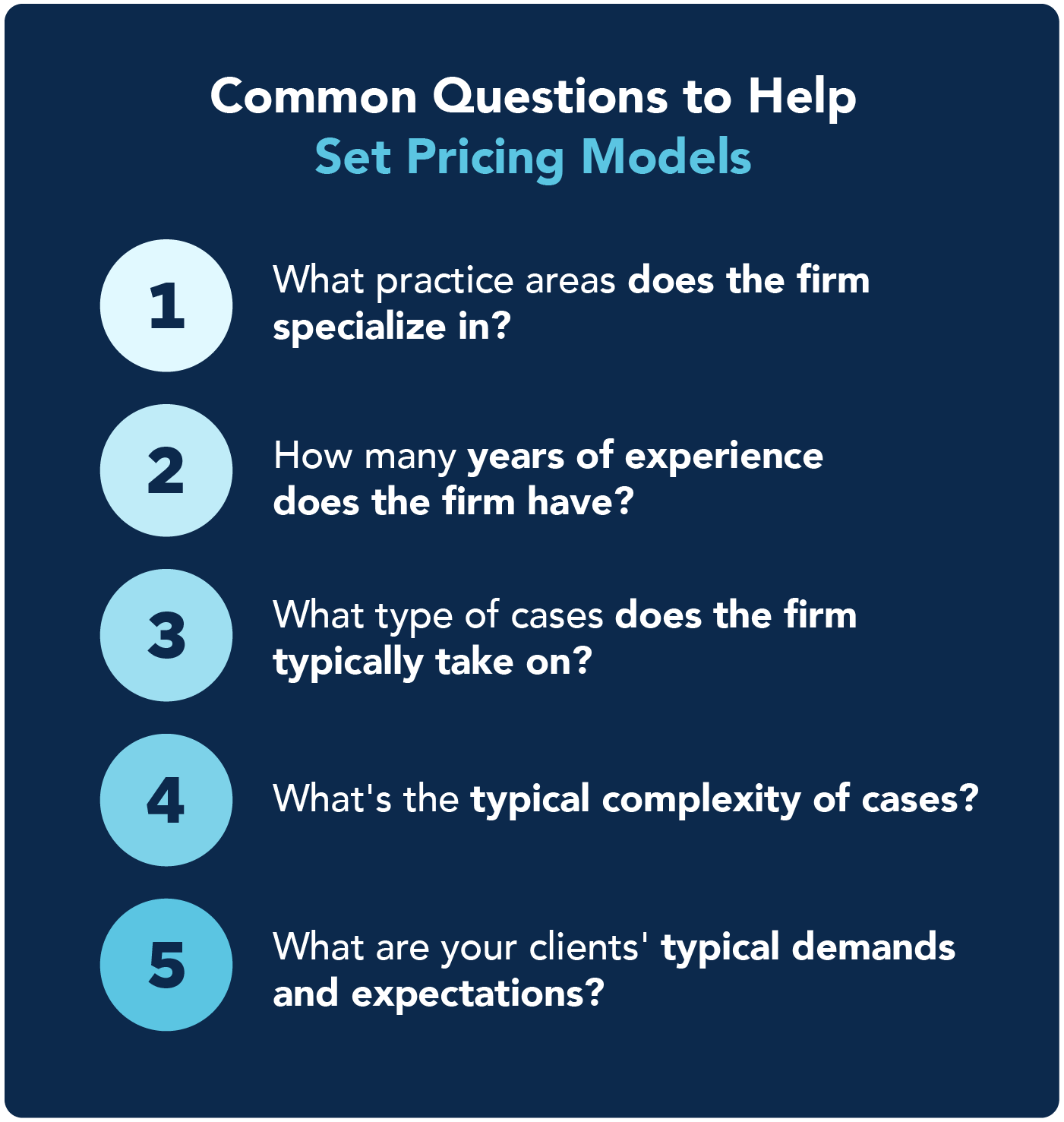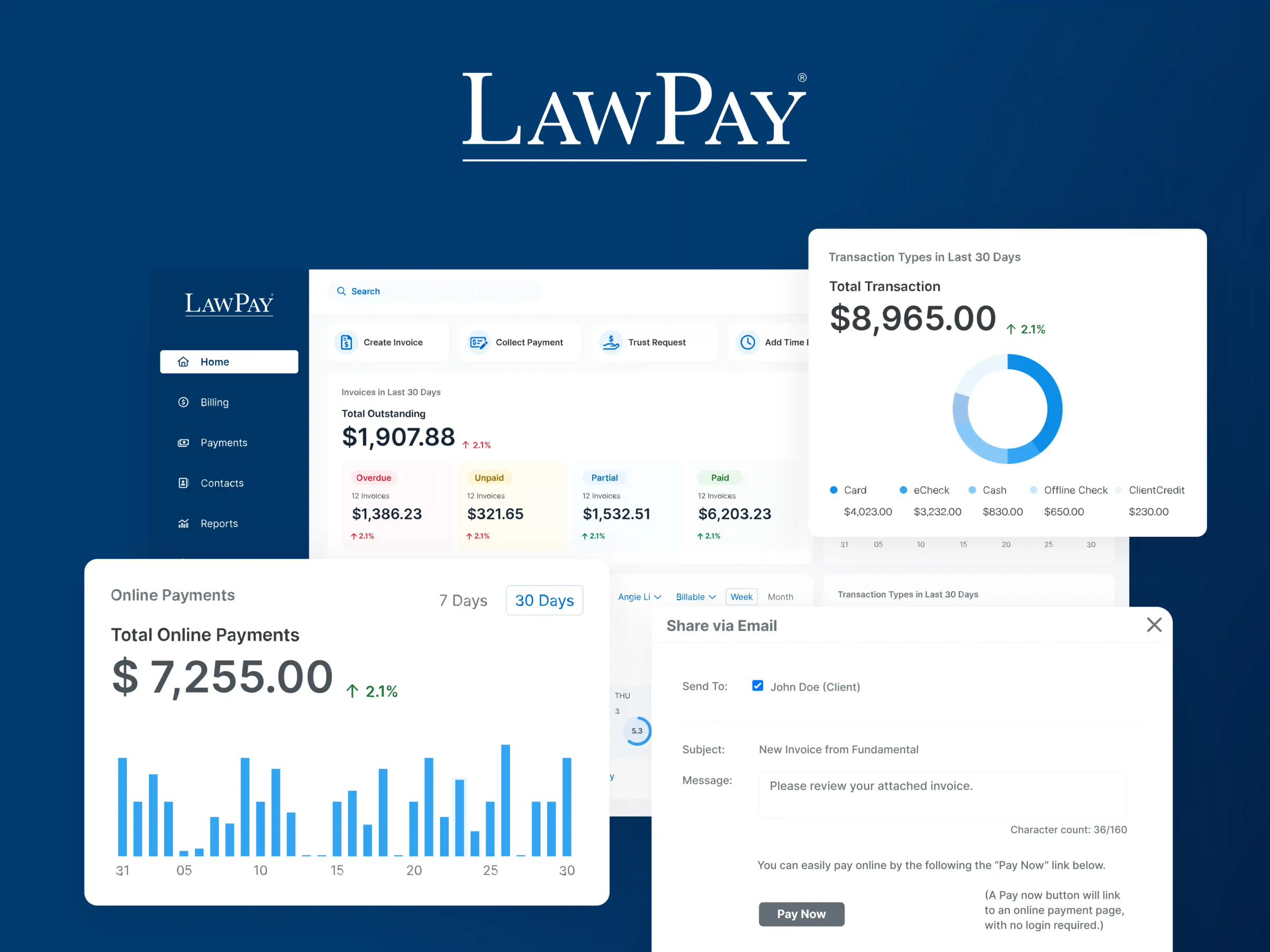Clients consider many factors when choosing the right law firm. But still, the conversation frequently boils down to cost. For many potential clients, law firm pricing determines their choice of legal counsel.
Effective law firm pricing extends far beyond simply ensuring your firm's profitability. It plays a crucial role in shaping your firm's identity and how clients perceive your value in the legal landscape. Determining lawyer prices is one of the most crucial business decisions your law firm can make, but it’s far from easy.
Savvy clients now actively compare legal fees online, leading to a greater demand for clear and predictable lawyer pricing. This has prompted many law firms to re-evaluate how they charge for their services and explore legal pricing tools to create more attractive and efficient models
To build a pricing plan that attracts more clients, it's important to understand a few key things:
What lawyer pricing includes
How legal pricing impacts your firm, branding, and clients
The available billing tools and models at your disposal to make changes
We'll cover these points and more in this article.
What Does Law Firm Pricing Mean?
Law firm pricing refers to the amount law firms charge clients for their legal services. Common client billing methods include flat fees, hourly billing, retainers, and other alternative fee arrangements (AFAs). While these billing methods remain a standard practice for many lawyers, the legal landscape is shifting.
Today's clients demand transparent pricing, flexible payment options, and value-based models. Lawyer payment plans have also become increasingly popular, aiding clients to pay for legal services over time. This means law firms adhering strictly to traditional pricing models risk falling behind.
Furthermore, many clients are now tech-savvy and actively research lawyers and their fees online. It’s critical to be competitive in the modern market and recognize that legal pricing is now about value, flexibility, and transparent client-centered solutions.
3 Common Law Firm Pricing Strategies
With client expectations changing constantly, how do modern law firms determine what “fair” pricing is for their services? The most important thing your firm can do is to find a pricing strategy that is client-focused, helps you stand out among the competition, and balances out the costs of starting a law firm. This will help you stand out among the competition and provide real value for your clients while maintaining profitability.
Here are some of the most frequently used strategies that modern law firms use when setting legal fees:
1. Cost-based
A cost-based pricing system uses the average costs required by the firm to perform a legal service plus an extra percentage markup to ensure a healthy profit margin. This is often calculated using a lawyer’s base hourly rate plus a fixed fee.
2. Competition-based
Many of today’s clients do extensive pricing research before choosing a lawyer. As a result, some law firms use a competition-based approach to pricing, which focuses on setting lawyer prices based on what competing law firms are charging. While this often translates to trying to explicitly undercut another law firm’s prices, the other firm’s fees can also simply be a reference point to stay competitive in the local market.
3. Value-based
A customer-value-based approach charges legal service fees based on the potential value of those legal services to the client. More specifically, value-based pricing means determining lawyer fees based on a variety of factors, including the type of case, market rates, overall risk, and more. This approach also can take into account the client’s goals and budget as well.
Perhaps more than any of the other models, value-based pricing is increasingly gaining steam among a wide number of legal professionals. Value-based pricing allows law firms to clearly quantify the value of their services and facilitate an open discussion with clients about their needs and expectations upfront. In addition to happier clients, value-based models can also benefit firms by fostering collaboration, boosting cash flow, and increasing efficiency.
Learn more about different fee structures in this free e-book: The Billable Hour Reimagined.
How Much Should a Lawyer Cost?
While choosing a law firm pricing strategy is key, the actual rates you set are equally important. Your pricing must sustain your business and facilitate growth while also demonstrating clear value to your clients. If a client doesn’t understand the connection between your fees and the benefits they receive, they may seek legal counsel elsewhere. Furthermore, a perceived lack of value can negatively impact your firm's reputation through online reviews and word-of-mouth.
To mitigate this risk, you need to set reasonable rates and effectively communicate the rationale behind them. A legal fee agreement can help ensure both parties are on the same page regarding these rates and the scope of work. And while there is no one-size-fits-all pricing solution, there are a few places to start.
Initially, researching the average lawyer fees for your state can provide a helpful benchmark. This can give you a general understanding of the typical cost for specific legal services in your region. However, it's important to remember that this is merely a starting point. Fees can vary significantly based on the specific practice area and the experience level of individual lawyers within a firm.
While ensuring your fees allow for profitability is essential, they must also be fair to clients. Offering fair prices isn’t just in your best interest as a business, but part of the ethical rules laid out by The American Bar Association.
How to Calculate the Cost of Your Legal Services
When starting a law firm, setting the exact rate for your services requires a careful balance between ensuring your firm's financial sustainability and effectively demonstrating your potential value to clients. While a higher rate might contribute to growth, it could deter clients who believe they can find comparable services at a lower cost. Conversely, setting your rates too low will cause you to constantly chase new work to keep the lights on.
You also may consider offering discounts or incentives. However, if you're moving to value-based pricing, your primary initial decision is how you'll structure those fees. Unlike hourly billing, value-based pricing demands a different approach. Since you won't be tracking time traditionally, strong financial forecasting and budgeting tools are crucial for setting prices that reflect your value and maintain your firm's financial health.
Law Firm Pricing Models
Deciding on a pricing model is crucial to both the health of your business and how potential clients view it. There are many ways you can charge clients, and you may even choose to mix and match different pricing models as you see fit. Every option comes with distinct advantages and disadvantages, which are important to understand in order to make the right decision for your firm.

Hourly Rate Pricing
Hourly rate billing is the most common law firm pricing strategy. In this model, lawyers track their time and bill clients based on the number of hours worked. Lawyers often use a billable hours chart to streamline this process.
Hourly rates vary significantly, depending on the lawyer's experience and the complexity of the case. And while it's relatively straightforward for firms to implement, this model presents both advantages and disadvantages.
Law firm benefits:
Simple to implement and understand
Directly compensates for time spent on a case
Can accommodate unpredictable or lengthy cases
Client benefits:
Cost-effective for straightforward, short cases
A clear breakdown of time spent on specific tasks (if detailed billing is provided)
Potential drawbacks:
Unpredictable and potentially high final costs for clients
Disincentivizes efficiency if there's no pressure to resolve matters quickly
Client anxiety about the cost of every communication
Susceptible to client concerns about "time padding"
Flat-Rate Pricing
A flat-rate fee is when a client is told exactly how much they will pay in advance. This type of fee is the most straightforward for clients, as there will be no surprises when they get the bill. Because of this cost visibility, flat-rate fees are often a popular choice for clients. Flat fees are structured to be paid in full upfront or in installments, usually based on certain milestones.
Law firm benefits:
Predictable revenue for specific services
Reduced need for detailed time tracking
Improved client satisfaction due to cost certainty
Client benefits:
Complete cost predictability from the outset
Easier budgeting for legal expenses
Reduced anxiety about unexpected bills
Potential drawbacks:
Profitability can be impacted if the case becomes more complex than anticipated
Requires accurate upfront assessment of the scope of work
Less suitable for unpredictable or highly complex cases
Success-Dependent Pricing
Success-dependent pricing, also known as contingency pricing, offers a way for clients to obtain legal representation without paying upfront fees. Instead, the attorney's payment is directly linked to the success of the case. Payment is typically calculated as a predetermined percentage of the client's financial recovery. The specifics of this arrangement, including what constitutes a 'successful outcome' and the agreed-upon percentage, are clearly defined in a Conditional Fee Agreement (CFA). This model is particularly beneficial for clients who might otherwise struggle to afford legal services at the outset.
Law firm benefits:
Access to clients who might not be able to afford upfront fees
Potential for significant returns in successful high-value cases
Aligns the attorney's interests directly with the client's success
Client benefits:
Access to legal representation without upfront financial burden
Reduced financial risk, as fees are only paid upon a successful outcome
Attorney is incentivized to achieve the best possible result
Potential drawbacks:
The firm bears the risk of not being paid if the case is unsuccessful, even after significant work
This may lead to lower overall earnings compared to hourly billing for the same amount of work if the contingency percentage doesn't compensate for the risk and time
May not be suitable or ethical in all types of legal cases (e.g., criminal defense, family law in some jurisdictions)
Retainer Pricing
Lawyer retainer pricing is when a client pays an upfront sum to a law firm to secure their future legal services. These funds are held in a client trust account and are only accessed by the attorney as work is performed, and the client is billed accordingly. This is ideal for long-term clients and for cases requiring ongoing work so that a lawyer can pay themselves more easily. However, when taking retainers, it is extremely important to be overly communicative with clients so they know exactly when they will be billed, how much they will be billed for, and if their retainer amount is running low.
Law firm benefits:
Provides an upfront influx of cash flow
Secures the attorney-client relationship for future work
Simplifies billing for ongoing legal services
Clients benefits:
Ensures the availability of a specific attorney or firm for their legal needs
Streamlines the payment process for long-term engagements
Provides a sense of security knowing funds are allocated for legal expenses
Potential drawbacks:
Requires careful management of trust accounts and billing records
This can be a significant upfront cost for clients
Opens the door to possible disputes if billing practices or communication are unclear
Sliding Scale Pricing
Sliding scale pricing is a flexible fee structure where the cost of legal services is adjusted based on the client's income and ability to pay. This approach aims to make legal representation more accessible to individuals who might not qualify for free legal aid but still face financial barriers. The specific income thresholds and corresponding fee adjustments are typically determined by the law firm. It's worth noting that legal fees are generally expected to be “fair and reasonable” based on factors beyond just income. This may include the complexity of the case, the lawyer’s experience and expertise, and the time required.
Law firm benefits:
Expands the firm's reach to a broader range of clients
Enhances the firm's reputation for social responsibility
Provides a consistent stream of work from clients who would otherwise go unrepresented
Client benefits:
Makes legal services more affordable and accessible
Allows individuals with limited financial resources to obtain necessary legal assistance
Provides a transparent and fair pricing mechanism based on their financial situation
Potential drawbacks:
Complex to administer, requiring careful income verification and fee calculation
Possibly lower overall revenue compared to standard fee structures
Requires a commitment to financial flexibility and a potential acceptance of lower profit margins for these clients
Blended Pricing
A blended fee is an alternative to traditional hourly billing. However, instead of different lawyers having different rates, the firm charges one average hourly rate for all the work on your case—regardless of which attorney handles the task. For example, a firm might establish a blended rate of $300 per hour whether the work is performed by a junior associate (whose individual rate might be lower) or a senior partner (whose rate would typically be higher). This approach helps clients have more predictable hourly costs and avoid unexpectedly high bills if senior lawyers spend a lot of time on their cases.
Law firm benefits:
Simplifies billing by using a single hourly rate across the team
Lets the firm assign tasks to the best person for the job without impacting the client's hourly cost
Can improve client relations by offering predictable hourly costs
Client benefits:
Provides greater certainty regarding hourly costs, regardless of who works on their case
Protects against high bills due to extensive work by senior, higher-rate attorneys
Can make budgeting for legal fees easier with a consistent hourly rate
Potential drawbacks:
Clients might overpay if the majority of the work is handled by less experienced, lower-rate attorneys
Requires careful cost management to ensure profitability with the blended rate
May not accurately reflect the value of highly specialized work performed by senior partners
Subscription-Based Pricing
Subscription-based law firms offer ongoing legal services for a recurring, flat monthly fee. Clients "subscribe" to a legal plan, gaining access to a defined set of services. Depending on the firm and plan, these services can vary greatly. Some examples include regular calls with an attorney, flat rates for repeat services like contract reviews, and access to tools like legal document templates. Ultimately, this model aims to build a continuous relationship between the client and the lawyer without the need for a full-time hire.
Law firm benefits:
Generates a stable and predictable recurring monthly revenue stream
Fosters long-term client relationships and encourages client retention
Can streamline service delivery for routine legal needs
Client benefits:
Provides predictable and manageable monthly legal expenses
Can provide cost-effective access to routine legal tasks like document review
Encourages regular interactions with legal counsel, potentially preventing larger problems
Potential drawbacks:
It can be tricky to decide which services to include in the subscription
Clients might feel they aren't using it enough if their legal needs are low in some months
Might not be the best for very complex or rare legal issues
Implementing Flexible Pricing With LawPay’s Billing and Payment Tools
Schedule a demo to see what LawPay can offer your firm.
Book Now
Modernizing your law firm involves pricing legal services to gain a competitive edge. To effectively manage diverse fee structures, the right legal pricing tools and software are essential. LawPay is specifically designed to streamline these processes in the legal industry.
Whether you're implementing hourly billing and need efficient time tracking, utilizing flat fees and requiring seamless billing and invoicing, or offering subscription models and need easy online payment options, LawPay provides tailored solutions. Discover how LawPay can optimize your firm's workflow and help your attorneys get paid 39% faster by scheduling a demo today.
About the author

Gabriela Jhean Content Writer
Gabriela Jhean is a Content Writer for leading legal software companies, including MyCase, Docketwise, CPACharge, CASEpeer, and LawPay—the #1 legal payment processor. She covers emerging legal technology, financial wellness for law firms, the latest industry trends, and more.
